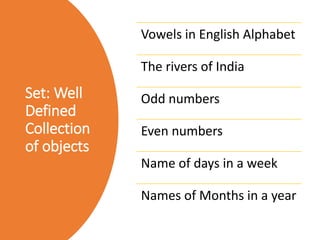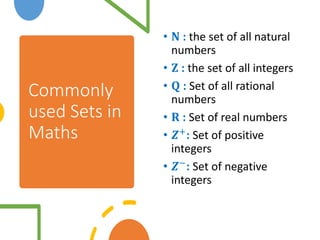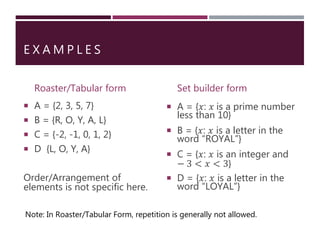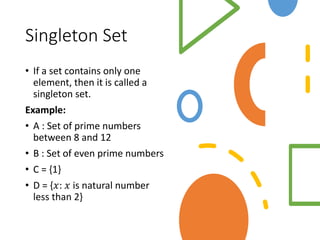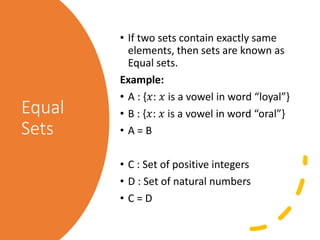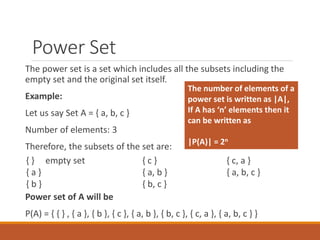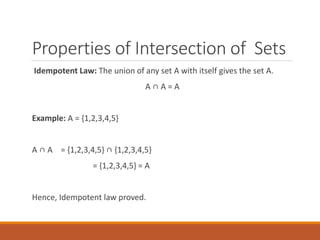Sets in Maths (Complete Topic)
- 1. Sets
- 2. Collection or Group What is common in all of them ?
- 3. Collection or Group of : Boys in your Class Girls in your Class Vowels in English Alphabet The rivers of India Odd numbers Even numbers
- 4. TYPE OF COLLECTION Not well defined Top 3 actors of India Top 3 Punjabi Singers Top 3 Hindi Songs Well Defined All Vowels in English Alphabet Name of all days in a week Name of all Months in a year Note: In Well defined collection, we can definitely decide whether a given object belongs to the collection or not.
- 5. Set: Well Defined Collection of objects Vowels in English Alphabet The rivers of India Odd numbers Even numbers Name of days in a week Names of Months in a year
- 6. Things to Remember Objects, elements and members of a set are synonymous terms Sets are usually denoted by Capital Letters like A,B,C,D,E etc. The elements of a set are represented by small letters like a,b,c,d,e etc
- 7. Commonly used Sets in Maths • 𝐍 : the set of all natural numbers • 𝐙 : the set of all integers • 𝐐 : Set of all rational numbers • 𝐑 : Set of real numbers • 𝒁+ : Set of positive integers • 𝒁−: Set of negative integers
- 8. Notation • A: set of odd numbers • 3 is a member of set A. • 2 is not a member of set A. • A: set of odd numbers • 3 ∈ A • 2 ∉ A • B: set of vowels in English Alphabet • ‘a’ is a member of set B. • ‘d’ is not a member of set B. • B: set of vowels in English Alphabet • a ∈ A • b ∉ A ∈ → is a member of (Belongs to) ∉ → is not a member of (does not Belong to)
- 9. W A Y S O F R E P R E S E N T I N G A S E T Roaster/Tabular form List all elements of a set. A is set of natural numbers less than 10 is → = set of → {} A = {1, 2, 3, 4, 5, 6, 7, 8, 9} {} → Braces , → Comma List elements using ellipsis. A = {1, 2, 3,…,9} … → Ellipsis Set builder form Based on common property between all elements of a set. A is set of natural numbers less than 10 A = {1, 2, 3, 4, 5, 6, 7, 8, 9} A = {𝑥 : 𝑥 is natural number and less than 10} A = {𝑥 : 𝑥 <10 and 𝑥 ∈ N} where N is a Set of natural numbers and : → such that
- 10. E X A M P L E S Roaster/Tabular form A = {2, 3, 5, 7} B = {R, O, Y, A, L} C = {-2, -1, 0, 1, 2} D {L, O, Y, A} Order/Arrangement of elements is not specific here. Set builder form A = {𝑥: 𝑥 is a prime number less than 10} B = {𝑥: 𝑥 is a letter in the word “ROYAL”} C = {𝑥: 𝑥 is an integer and − 3 < 𝑥 < 3} D = {𝑥: 𝑥 is a letter in the word “LOYAL”} Note: In Roaster/Tabular Form, repetition is generally not allowed.
- 11. Empty Set • If a set doesn’t have any element, it is known as an empty set or null set or void set. This set is represented by ϕ or {}. Example: • A : Set of prime numbers between 24 and 28 • B : Set of even prime numbers greater than 2 • C = { } • D = {𝑥: 𝑥 is natural number less than 1}
- 12. Singleton Set • If a set contains only one element, then it is called a singleton set. Example: • A : Set of prime numbers between 8 and 12 • B : Set of even prime numbers • C = {1} • D = {𝑥: 𝑥 is natural number less than 2}
- 13. Finite Set If a set contains no element or fixed number of elements, it is called a finite set. Example: A : Set of months in a year B : Set of prime numbers less than 10 C = {1, 2, 3, 4, 5} D = {𝑥: 𝑥 is natural number less than 6}
- 14. Infinite Set • If a set contains endless number of elements, then it is called an infinite set. Example: • A : Set of prime numbers • B : Set of even numbers • C = {1,3,5,7,…} • D = {𝑥: 𝑥 is a negative integer}
- 15. Cardinal Number of a Set • The cardinal number of a finite set A is the number of distinct members of the set. • It is denoted by n(A). • The cardinal number of the empty set is 0. • cardinal number of an infinite set is not defined. Example: • If A= {-3, -2, -1, 0, 1} then n(A) = 5 • If B : Set of months in a year, then n(B) = 12
- 16. Equivalent Sets • Two finite sets with an equal number of members are called equivalent sets. • If the sets A and B are equivalent, we write A ↔ B and read this as • “A is equivalent to B”. • A ↔ B if n(A) = n(B) . Example: • X= {0, 2, 4} • Y= {x : x is a letter of the word DOOR} . • As n(X) = 3 and n(Y) = 3. So, X ↔ Y .
- 17. Equal Sets • If two sets contain exactly same elements, then sets are known as Equal sets. Example: • A : {𝑥: 𝑥 is a vowel in word “loyal”} • B : {𝑥: 𝑥 is a vowel in word “oral”} • A = B • C : Set of positive integers • D : Set of natural numbers • C = D
- 18. Non- Equal Sets • If two sets do not contain exactly same elements, then sets are known as Non-Equal sets. Example: • A : {𝑥: 𝑥 is a vowel in word “loyal”} • B : {𝑥: 𝑥 is a vowel in word “towel”} • A ≠ B • C : Set of negative integers • D : Set of natural numbers • C ≠ D
- 19. Subset and Superset • If every element of set A is also an element of set B, then A is called as subset of B or B is superset of A. • It is denoted as A ⊆ B (subset) or B ⊇ A (superset) Example: A : set of vowels in English alphabet B : set of letters in English alphabet A ⊆ B or B ⊇ A C = {1, 2, 3, 4, 5} D = {2, 3} D ⊆ C or C ⊇ D
- 20. Proper Subset and Proper Superset • If A is a subset of B and A ≠ B, then A is proper subset of B • If B is a superset of A and A ≠ B, then B is proper superset of A • It is denoted as A ⊂ B (subset) or B ⊃ A (superset) Example: C = {1, 2, 3, 4, 5} D = {2, 3} D ⊂ C or C ⊃ D
- 21. INTERVALS Let a, b ∈ R and a < b [ {𝑥 : 𝑥 ∈ R and a < 𝑥 < b} {𝑥 : 𝑥 ∈ R and a ≤ 𝑥 ≤ b} {𝑥 : 𝑥 ∈ R and a < 𝑥 ≤ b} {𝑥 : 𝑥 ∈ R and a≤ 𝑥 < b}
- 22. Power Set The power set is a set which includes all the subsets including the empty set and the original set itself. Example: Let us say Set A = { a, b, c } Number of elements: 3 Therefore, the subsets of the set are: Power set of A will be P(A) = { { } , { a }, { b }, { c }, { a, b }, { b, c }, { c, a }, { a, b, c } } { } empty set { a } { b } { c } { a, b } { b, c } { c, a } { a, b, c } The number of elements of a power set is written as |A|, If A has ‘n’ elements then it can be written as |P(A)| = 2n
- 23. Universal Set • A Universal Set is the set of all elements under consideration, denoted by U. All other sets are subsets of the universal set. • Example: • A : set of equilateral triangles • B : set of scalene triangles • C : set of isosceles triangles • U : set of triangles (Universal set) • A ⊂ U, B ⊂ U, C ⊂ U
- 24. VENN DIAGRAM A Venn diagram used to represent all possible relations of different sets. It can be represented by any closed figure, whether it be a Circle or a Polygon (square, hexagon, etc.). But usually, we use circles to represent each set. Example: U = {1,2,3,4,5,6,,8,9,10} A = {2,4,6,8,10} Intersecting sets Non Intersecting sets Subsets
- 25. Operation on sets Operations on numbers: Addition(+) Subtraction(−) Multiplication(×) Division(÷) Set operations are the operations that are applied on two more sets to develop a relationship between them. There are four main kinds of set operations which are: Union of sets Intersection of sets Complement of a set Difference between sets
- 26. Union Notation: A ∪ B Examples: {1, 2} ∪ {1, 2} = {1, 2} {1, 2, 3} ∪ {4, 5, 6} = {1, 2, 3, 4, 5, 6} {1, 2, 3} ∪ {3, 4} = {1, 2, 3, 4} The union of sets A and B is the set of items that are in either A or B.
- 27. Properties of Union of Sets Commutative Law: The union of two or more sets follows the commutative law i.e., if we have two sets A and B then, A ∪ B = B ∪ A Example: A = {a, b} and B = {b, c, d} So, A ∪ B = {a,b,c,d} B ∪ A = {b,c,d,a} A ∪ B = B ∪ A Hence, Commutative law proved.
- 28. Properties of Union of Sets Associative Law: The union operation follows the associative law i.e., if we have three sets A, B and C then (A ∪ B) ∪ C = A ∪ (B ∪ C) Example: A = {a, b} and B = {b, c, d} and C = {a,c,e} (A ∪ B) ∪ C = {a,b,c,d} ∪ {a,c,e} = {a,b,c,d,e} A ∪ (B ∪ C) = {a, b} ∪ {b,c,d,e} = {a,b,c,d,e} Hence, Associative law proved.
- 29. Properties of Union of Sets Identity Law: The union of an empty set with any set A gives the set itself. A ∪ ϕ = A Example: A = {a,b,c} and ϕ = {} A ∪ ϕ = {a,b,c} ∪ {} = {a,b,c} = A Hence, Identity law proved.
- 30. Properties of Union of Sets Idempotent Law: The union of any set A with itself gives the set A. A ∪ A = A Example: A = {1,2,3,4,5} A ∪ A = {1,2,3,4,5} ∪ {1,2,3,4,5} = {1,2,3,4,5} = A Hence, Idempotent Law proved.
- 31. Properties of Union of Sets Law of 𝐔 : The union of a universal set U with its subset A gives the universal set itself. A ∪ U = U Example: A = {1,2,4,7} and U = {1,2,3,4,5,6,7} A ∪ U = {1,2,4,7} ∪ {1,2,3,4,5,6,7} = {1,2,3,4,5,6,7} = U Hence, Law of U proved.
- 32. Intersection Notation: A ∩ B Examples: {1, 2, 3} ∩ {3, 4} = {3} {1, 2, 3} ∩ {4, 5, 6} = ϕ or {} {1, 2} ∩ {1, 2} = {1, 2} The intersection of sets A and B is the set of items that are in both A and B.
- 33. Properties of Intersection of Sets Commutative Law: The union of two or more sets follows the commutative law i.e., if we have two sets A and B then, A ∩ B = B ∩ A Example: A = {a, b} and B = {b, c, d} So, A ∩ B = {b} B ∩ A = {b} So, A ∩ B = B ∩ A Hence, Commutative law proved.
- 34. Properties of Intersection of Sets Associative Law: The union operation follows the associative law i.e., if we have three sets A, B and C then (A ∩ B) ∩ C = A ∩ (B ∩ C) Example: A = {a, b, c} and B = {b, c, d} and C = {a, c, e} (A ∩ B) ∩ C = {b, c} ∩ {a, c, e} = {c} A ∩ (B ∩ C) = {a, b, c} ∩ {c} = {c} Hence, Associative law proved.
- 35. Properties of Intersection of Sets Idempotent Law: The union of any set A with itself gives the set A. A ∩ A = A Example: A = {1,2,3,4,5} A ∩ A = {1,2,3,4,5} ∩ {1,2,3,4,5} = {1,2,3,4,5} = A Hence, Idempotent law proved.
- 36. Properties of Intersection of Sets Law of 𝐔 : The union of a universal set U with its subset A gives the universal set itself. A ∩ U = A A = {1,2,4,7} and U = {1,2,3,4,5,6,7} Example: A ∩ U = {1,2,4,7} ∩ {1,2,3,4,5,6,7} = {1,2,4,7} = A Hence, Law of U proved.
- 37. Difference Notation: A − B Examples: {1, 2, 3} – {2, 3, 4} = {1} {1, 2} – {1, 2} = 𝜙 {1, 2, 3} – {4, 5} = {1, 2, 3} The difference of sets A and B is the set of items that are in A but not B.
- 38. Complement Notation: A’ or Ac Examples: • If U = {1, 2, 3} and A = {1, 2} then Ac = {3} • If U = {1, 2, 3, 4, 5, 6} and A = {1, 2} then Ac = {3, 4, 5, 6} The complement of set A is the set of items that are in the universal set U but are not in A.
- 39. Properties of Complement Sets Complement Laws: • A ∪ A’ = U • A ∩ A’ = 𝜙 For Example: • If U = {1 , 2 , 3 , 4 , 5 } and A = {1 , 2 , 3 } then • A’ = {4 , 5} • A ∪ A’ = { 1 , 2 , 3 , 4 , 5} = U • A ∩ A’ = {} = 𝜙
- 40. Properties of Complement Sets Law of Double Complementation: • (A’)’ = A For Example: • If U = {1 , 2 , 3 , 4 , 5 } and A = {1 , 2 , 3 } then • A’ = {4 , 5} • (A’)’ = {1 , 2 , 3} = A • (A’)’ = A
- 41. Properties of Complement Sets Law of empty set and universal set: • 𝜙’ = U • U’ = 𝜙
- 42. DE MORGAN’S LAW The complement of the union of two sets A and B is equal to the intersection of the complement of the sets A and B. (A ∪ B)’ = A’ ∩ B’
- 43. INCLUSION EXCLUSION PRINCIPLE n(A U B) = n(A) + n(B) – n(A ∩ B) n(A) = 5 n(B) = 6 n(A ∩ B) = 2 n(A U B) = 9




